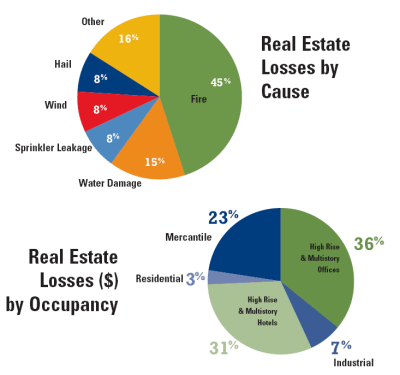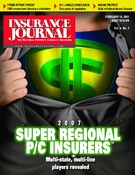Fire, water, hail and wind reel in big losses for business, but many could be prevented
The exposures faced by businesses in catastrophe-prone areas have been well-documented post-Katrina and facility owners and managers have responded by focusing mitigation efforts on these high priority risks. But what they cannot afford to overlook is the management and mitigation of the everyday hazards all businesses still face.
We recently conducted a study of 240 losses in real estate occupancies that exceeded $100,000. We found that about 83 percent of the property losses came from five main perils. Fire was the greatest peril with about 45 percent of the losses, water damage was next with 15 percent, sprinkler leakage, wind and hail each came in at 8 percent and various other causes rounded it out at 16 percent. Details of our findings are included in this article, as well as some useful information on what risk managers and facility owners can do to help prevent or reduce property damage in this occupancy.
A look at the losses
Of the losses caused by these five perils, 146 occurred in offices and hotels — the two occupancies that are most frequently multistory or high-rise buildings. Because the effects of fire, and especially water, are much worse in high-rise buildings since water and smoke travel to other floors, these occupancies were considered separately in the study from mercantile, light industrial and residential properties that are most often low-rise.
Fire was the main cause of the multistory losses — accounting for 50 percent of the total. The major causes of these fires were occupant or guest activities such as electrical equipment left on after closing, contractors with torches, guests burning candles and incendiary causes. Automatic sprinklers were only present in slightly less than half of the cases and the average loss for these sprinklered fires was about one third less than for unsprinklered fires.
Accidental water damage, the second highest loss cause, came mainly from piping systems and sprinkler leakage in non-fire situations. These two leak sources were a significant factor in losses in multistory and high-rise buildings and together they accounted for about 36 percent of the loss. In many cases, the water ran for an exceedingly long period of time causing serious damage on floors below the incident. Obviously, the more water that flows, the more difficult it is to dry out the facility. And of course, the longer drying is delayed, the greater the possibility of mold — typically at the lower half of a wall behind vinyl wallpaper where moisture is trapped and the paste encourages growth.
While more than half the losses studied occurred in high-rise occupancies, low-rise buildings are also vulnerable to big problems. The low-rise, or one and two story properties, have the same issues with fire as high-rise properties — just at a much lower loss ratio — and get the same benefits from sprinklers when fire does occur. Fires in residential properties were most often related to tenant activities and the rate of fire seemed to vary inversely with the degree of management control, maintenance and security. In mercantile buildings, restaurants are a common source of loss and the causes are almost always related to cooking equipment or exhaust ducts. Frequent causes are grease fires in ducts or simply continuous heating where ducts pass through combustible construction.
As with fire, management, maintenance and security staff in both high- and low-rise buildings should be familiar with water control valves and have in place strict procedures for promptly shutting water off in emergencies. Shutting sprinklers off should be coordinated with local fire authorities as special rules may apply. Even if sprinklers operate during a fire, building staff should assist the fire department in locating control valves so they can be shut down as soon as the authorized person gives the order. Building owners and managers need to have an emergency plan in place for immediate and aggressive drying in cases of water damage. This includes locating and contracting with specialists and salvage equipment companies prior to any emergency. The plan should include specific procedures for the salvage of highly susceptible property such as rugs and valuable wallpaper.
In addition to loss from fire and water damage, the risk posed by snow loading is also a significant threat. In the study, light industrial buildings proved to be especially susceptible to collapse under unusual snow or water loads. This may be attributed to a couple of factors: Light industrial buildings tend to be of modular construction and in some cases, have inadequate bracing to resist the twisting of secondary roof elements like purlins or trusses. Obviously when a structural element twists out of its intended position, it loses its structural integrity. Snow also tends to drift into areas where roof levels change and therefore, it exerts an even greater snow load than snow on the flat surfaces of the roof. Management should establish a safe roof snow removal policy that combines training, proper protection and equipment to ensure quick, efficient mitigation of the risk posed by snow load.
Preventing or reducing the losses
So here is what risk managers and facility owners can do to help prevent or reduce property damage.
1. Prevent fires by controlling dangerous behavior by occupants or guests such as requiring contractors to adhere to strict safety standards, especially when using open flame. Prohibit other dangerous behaviors such as leaving electrical or heat producing equipment on when unattended, using candles and smoking.
2. Prevent fires by maintaining a high level of housekeeping around cooking equipment and in exhaust ducts. Make sure that cooking exhaust ducts pass through combustible construction with adequate clearance.
3.Control fires by installing automatic sprinklers wherever the building or contents are combustible and install special extinguishing systems over cooking equipment.
4. Routinely inspect sprinkler and special extinguishing systems to assure that valves are open and they are in good operating condition.
5. Prevent excessive water damage by having a well-established procedure for shutting off water. Ensure that all management, maintenance and security staff know where water control valves are located and are familiar with the procedure for valve control. This should include valves on the public piping leading into the premises. Post caution signs at sidewall sprinklers to prevent occupants from hanging clothes on them.
6. Coordinate the operation of sprinkler control valves in both fire and non-fire situations with the local fire department as there may be special rules that allow the sprinklers to run until it is safe to shut them off.
7. Minimize the growth of mold by having an aggressive plan in place for drying out after a water emergency or fire. This should include locating local specialists and equipment for drying important items like rugs and valuable wallpaper.
8. Prevent roof wind damage by inspecting and properly fastening roof flashing at the edges of roofs.
9. Prevent roof collapse by ensuring that light modular buildings have proper bracing to prevent structural element twisting.
10. Avoid roof collapse by having an emergency plan for removing snow accumulation concentrating on roof level changes where drifting snow occurs. Keep roof drains clear to prevent unnecessary water accumulation.
When creating their plans for disaster preparedness or business interruption from high-cat exposures, building owners and managers should take care to include planning for non-cat exposures that occur more frequently, and can have a more lasting impact, than a low-frequency, high-cat event.
Ralph Tiede is the vice president of Loss Prevention for Liberty Mutual Property.
Topics Catastrophe Profit Loss Property
Was this article valuable?
Here are more articles you may enjoy.



 Harvard Study Again Stirs the Pot on Demotech Ratings of Florida Carriers
Harvard Study Again Stirs the Pot on Demotech Ratings of Florida Carriers  Former MLB Player, 3 Others Charged with Staging Auto Accident in Miami
Former MLB Player, 3 Others Charged with Staging Auto Accident in Miami  Zuckerberg Avoids Personal Liability in Meta Addiction Suits
Zuckerberg Avoids Personal Liability in Meta Addiction Suits  Supreme Court Makes It Easier to Sue for Job Discrimination
Supreme Court Makes It Easier to Sue for Job Discrimination 


